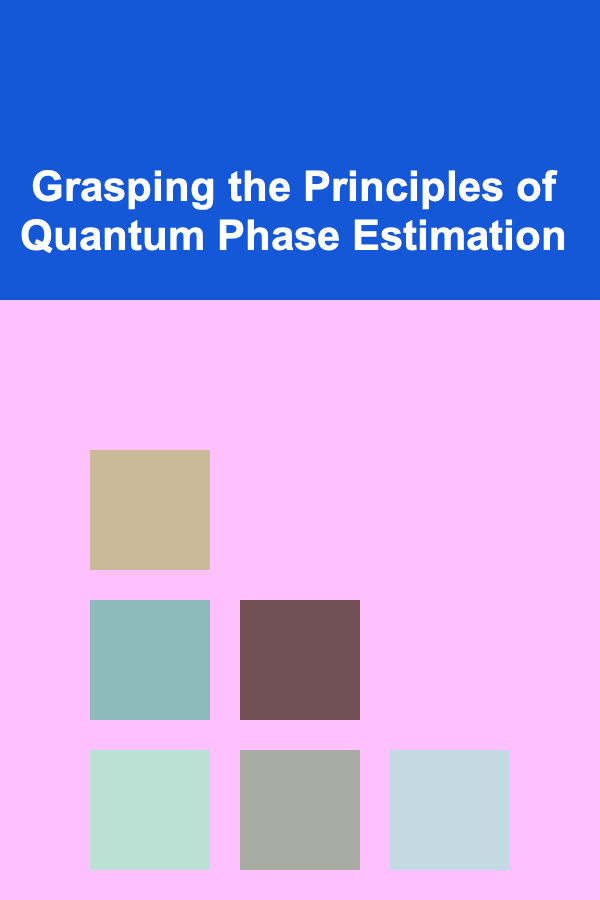
Grasping the Principles of Quantum Phase Estimation
ebook include PDF & Audio bundle (Micro Guide)
$12.99$5.99
Limited Time Offer! Order within the next:

Quantum Phase Estimation (QPE) is a crucial quantum algorithm that lies at the heart of many other powerful quantum algorithms, including Shor's factoring algorithm and quantum simulation algorithms. It provides a means to estimate the eigenvalue (specifically, the phase) of a unitary operator. While the underlying mathematics might seem daunting at first, a thorough understanding of the core principles, combined with careful step-by-step analysis, can make QPE accessible and empower you to harness its potential.
Fundamentals: Unitary Operators and Eigenvalues
Before diving into the QPE algorithm itself, it's essential to have a firm grasp of the foundational concepts of unitary operators and eigenvalues. These are the building blocks upon which QPE rests.
Unitary Operators
A unitary operator, denoted by U, is a transformation that preserves the inner product between vectors. Mathematically, this is expressed as U^†^U = UU^†^= I, where U^†^ is the conjugate transpose of U, and I is the identity operator. In the context of quantum computing, unitary operators represent valid quantum gates, ensuring that quantum evolution is reversible and preserves probabilities. Think of them as rotations and reflections in Hilbert space.
Examples of unitary operators include:
- The Hadamard gate (
H) - The Pauli gates (
X,Y,Z) - Rotation gates (
R~x~,R~y~,R~z~) - Controlled gates (e.g., CNOT, controlled-U)
Eigenvalues and Eigenvectors
An eigenvector of a linear operator (like a unitary operator) is a non-zero vector that, when the operator is applied to it, only changes by a scalar factor. This scalar factor is called the eigenvalue. Mathematically, for an operator U and an eigenvector |ψ⟩, we have:
U|ψ⟩ = e^2πiθ^|ψ⟩
Here, e^2πiθ^ is the eigenvalue corresponding to the eigenvector |ψ⟩, and θ is the phase that QPE aims to estimate. The phase θ is a real number between 0 and 1 (exclusive of 1, inclusive of 0), and its value is crucial for many quantum algorithms. The factor of 2π is conventional and simplifies the subsequent calculations within QPE.
The goal of QPE is precisely to determine this phase θ for a given unitary operator U and a corresponding eigenvector |ψ⟩. Knowing U and |ψ⟩ is a prerequisite for using QPE.
The Quantum Phase Estimation Algorithm: A Step-by-Step Breakdown
The QPE algorithm consists of several key steps, which can be summarized as follows:
- Initialization: Prepare the quantum registers.
- Controlled Unitary Operations: Apply controlled-U operations.
- Inverse Quantum Fourier Transform (IQFT): Perform the IQFT on the first register.
- Measurement: Measure the first register to obtain an estimate of the phase.
Let's delve into each of these steps in detail:
1. Initialization
The QPE algorithm utilizes two quantum registers:
- The first register (the control register): This register consists of
tqubits, initialized to the state|0⟩^⊗t^. The number of qubits,t, determines the precision of the phase estimation. More qubits lead to a more accurate estimate ofθ. - The second register (the target register): This register holds the eigenvector
|ψ⟩of the unitary operatorU. This eigenvector is assumed to be known. The target register can have as many qubits as needed to represent the eigenvector.
Therefore, the initial state of the entire system is:
|0⟩^⊗t^⊗ |ψ⟩
2. Controlled Unitary Operations
This step is the heart of the QPE algorithm. It involves applying a series of controlled-U operations, where the control qubits are the qubits in the first register, and the target qubits are the qubits in the second register holding |ψ⟩. Specifically, we apply controlled-U^2^j^^ operations, where j ranges from 0 to t-1.
Let's break this down further:
- For each qubit
j(ranging from 0 tot-1) in the control register, we apply the unitary operatorU^2^j^^ to the target register only if thej-th qubit in the control register is in the state|1⟩. - The exponent
2^j^ means that we are applyingUto the power of2^j^. This can be achieved by applyingUsequentially2^j^ times. Importantly, in practice, we can often efficiently implementU^2^j^^ directly without actually applyingU2^j^ times.
After applying all the controlled-U^2^j^^ operations, the state of the system becomes:
(1/√2^t^) ∑~x=0~^2^t^-1^|x⟩ ⊗ U^x^|ψ⟩
Since |ψ⟩ is an eigenvector of U with eigenvalue e^2πiθ^, we can rewrite this as:
(1/√2^t^) ∑~x=0~^2^t^-1^|x⟩ ⊗ e^2πiθx^|ψ⟩ = (1/√2^t^) (∑~x=0~^2^t^-1^e^2πiθx^|x⟩) ⊗ |ψ⟩
Notice that the eigenvector |ψ⟩ is now factored out. The first register is now in a superposition of states |x⟩, where each state is weighted by a complex phase e^2πiθx^. This is where the magic happens, as the phase θ is now encoded in the amplitudes of the states in the first register.
3. Inverse Quantum Fourier Transform (IQFT)
The next crucial step is to apply the Inverse Quantum Fourier Transform (IQFT) to the first register. The QFT is a quantum algorithm that transforms a state from the computational basis to the Fourier basis, and the IQFT performs the reverse transformation.
The QFT applied to a state |x⟩ transforms it to:
QFT |x⟩ = (1/√N) ∑~y=0~^N-1^e^2πixy/N^|y⟩
Where N is the size of the Hilbert space, in this case, N = 2^t^.
Therefore, the IQFT applied to a state |x⟩ transforms it to:
IQFT |x⟩ = (1/√N) ∑~y=0~^N-1^e^-2πixy/N^|y⟩
Applying the IQFT to the first register transforms the state from:
(1/√2^t^) ∑~x=0~^2^t^-1^e^2πiθx^|x⟩
to:
(1/2^t^) ∑~x=0~^2^t^-1^∑~y=0~^2^t^-1^e^2πiθx^e^-2πixy/2^t^^|y⟩ = (1/2^t^) ∑~y=0~^2^t^-1^(∑~x=0~^2^t^-1^e^2πix(θ - y/2^t^)^) |y⟩
This seemingly complex expression simplifies significantly. Notice that the inner summation is a geometric series. The magnitude of the amplitude associated with state |y⟩ is large when θ is close to y/2^t^, and small otherwise. In other words, the IQFT concentrates the probability amplitude around the state |y⟩ that is closest to the scaled phase θ * 2^t^.
4. Measurement
Finally, we measure the first register in the computational basis. The measurement outcome, denoted as y (an integer between 0 and 2^t^-1), provides an estimate of the phase θ. Specifically, our estimate of the phase is:
θ ≈ y / 2^t^
The accuracy of this estimate depends on the number of qubits, t, in the first register. The more qubits, the finer the granularity of the possible values of y/2^t^, and therefore the more accurate our estimation of θ.
Understanding the Accuracy and Error
The QPE algorithm doesn't provide the exact phase θ with absolute certainty. It provides an estimate with a certain probability of success. The accuracy of the estimation is directly related to the number of qubits (t) used in the control register.
For instance, if we want to estimate the phase θ to n bits of precision with a probability of at least 1 - ε, then the number of qubits t required in the control register is:
t = n + ⌈log~2~(2 + 1/(2ε))⌉
This formula highlights the trade-off between precision and the probability of success. Increasing the desired precision (n) or the desired probability of success (decreasing ε) requires more qubits in the control register.
There are two primary sources of error in QPE:
- Discretization error: Since we are representing the phase
θas a fractiony/2^t^, there is a finite resolution. Ifθis not exactly representable as such a fraction, we will have a small error. Increasingtreduces this error. - Probability of incorrect measurement: Even with a large
t, there is a non-zero probability that the measurement outcome will deviate from the closest integer toθ * 2^t^. This probability is related to the distribution of amplitudes after the IQFT.
Example: Estimating the Phase of the T-gate
Let's illustrate the QPE algorithm with a concrete example: estimating the phase of the T-gate. The T-gate is a single-qubit gate defined as:
T = [[1, 0], [0, e^iπ/4^]]
The T-gate is a rotation around the Z-axis by π/4 radians. An eigenvector of the T-gate is simply |1⟩, with a corresponding eigenvalue of e^iπ/4^= e^2πi(1/8)^. Therefore, the phase we want to estimate is θ = 1/8.
Let's use two qubits (t=2) in the control register. This means we can represent the phase with a precision of 2 bits (i.e., multiples of 1/4).
Steps:
- Initialization:
|00⟩ ⊗ |1⟩ - Controlled Unitary Operations:
- Apply Controlled-T^2^0^^ = Controlled-T to the target qubit if the least significant qubit of the control register is |1⟩.
- Apply Controlled-T^2^1^^ = Controlled-T^2^ to the target qubit if the most significant qubit of the control register is |1⟩. Note that
T^2^ is a rotation by π/2, often called the S gate.
- IQFT: Apply the IQFT to the control register.
- Measurement: Measure the control register.
Expected Outcome: With t=2, the possible measurement outcomes are 00, 01, 10, and 11, corresponding to phase estimates of 0/4, 1/4, 2/4, and 3/4, respectively. Since the true phase is 1/8, the closest estimate within the available resolution (1/4) is 0/4. However, due to the probabilistic nature of QPE, we might observe other outcomes as well. With more qubits, the outcome would concentrate near 001 (representing 1/8).
Applications of Quantum Phase Estimation
QPE is not typically used as a standalone algorithm for practical problems. Its primary role is as a subroutine within more complex quantum algorithms. Some of the most significant applications of QPE include:
- Shor's Factoring Algorithm: QPE is a crucial component of Shor's algorithm, which efficiently factors large numbers on a quantum computer, breaking widely used classical encryption schemes like RSA.
- Quantum Simulation: QPE allows for the efficient simulation of quantum systems, such as molecules and materials. This is achieved by estimating the eigenvalues of the Hamiltonian operator, which governs the time evolution of the system. Knowing the eigenvalues allows us to determine the energy levels and other properties of the system.
- Quantum Metrology: QPE can be used to estimate physical parameters with high precision, surpassing the limits of classical measurement techniques. This has applications in fields such as sensing and imaging.
- Eigenvalue Estimation in General: Beyond unitary operators derived from physical systems, QPE can be applied to estimate the eigenvalues of any unitary operator, providing a powerful tool for analyzing quantum circuits and algorithms.
Advanced Topics and Considerations
While the basic QPE algorithm is relatively straightforward, there are several advanced topics and considerations that are important for practical implementations and more sophisticated applications:
- Iterative Phase Estimation: Iterative phase estimation is a variation of QPE that avoids the need for a controlled-
U^2^j^^ gate for large values ofj. It achieves this by iteratively refining the phase estimate, using classical feedback to adjust the quantum circuit. - Robust Phase Estimation: Robust phase estimation techniques are designed to be more resilient to noise and imperfections in the quantum hardware. These techniques often involve using error correction or other methods to mitigate the effects of noise.
- Optimized Circuit Implementations: Implementing QPE efficiently on a quantum computer requires careful optimization of the quantum circuit. This includes minimizing the number of gates, reducing the circuit depth, and choosing appropriate gate decompositions.
- Dealing with Unknown Eigenvectors: The standard QPE algorithm assumes that the eigenvector
|ψ⟩is known. In some cases, however, the eigenvector may be unknown. There are variations of QPE that can be used to estimate the phase even when the eigenvector is unknown, often involving a preparation step to create an approximation of the eigenvector.
Conclusion
Quantum Phase Estimation is a cornerstone of quantum algorithms, providing a powerful technique for extracting information about the eigenvalues of unitary operators. By understanding the fundamental principles of unitary operators, eigenvalues, and the step-by-step execution of the QPE algorithm, you can unlock its potential and apply it to a wide range of quantum computing applications. While the mathematics might seem complex at first, breaking down the algorithm into smaller, digestible pieces, and working through concrete examples, will build your intuition and enable you to master this essential quantum tool. As quantum computing technology continues to develop, QPE will undoubtedly play an increasingly important role in solving complex problems across various scientific and technological domains.

How to Establish a System for Incoming Invoices
Read More
How to Make Money Online as a Podcast Scriptwriter: 10 Actionable Ideas
Read More
How to Secure Sliding Glass Doors and Windows Effectively
Read More
IT Consultant's Handbook: Navigating Technology Trends and Driving Business Innovation
Read More
How to Explore Metaverse Crypto Projects
Read More
Exploring Dwarf Planets: A Journey Beyond the Giants
Read MoreOther Products

How to Establish a System for Incoming Invoices
Read More
How to Make Money Online as a Podcast Scriptwriter: 10 Actionable Ideas
Read More
How to Secure Sliding Glass Doors and Windows Effectively
Read More
IT Consultant's Handbook: Navigating Technology Trends and Driving Business Innovation
Read More
How to Explore Metaverse Crypto Projects
Read More